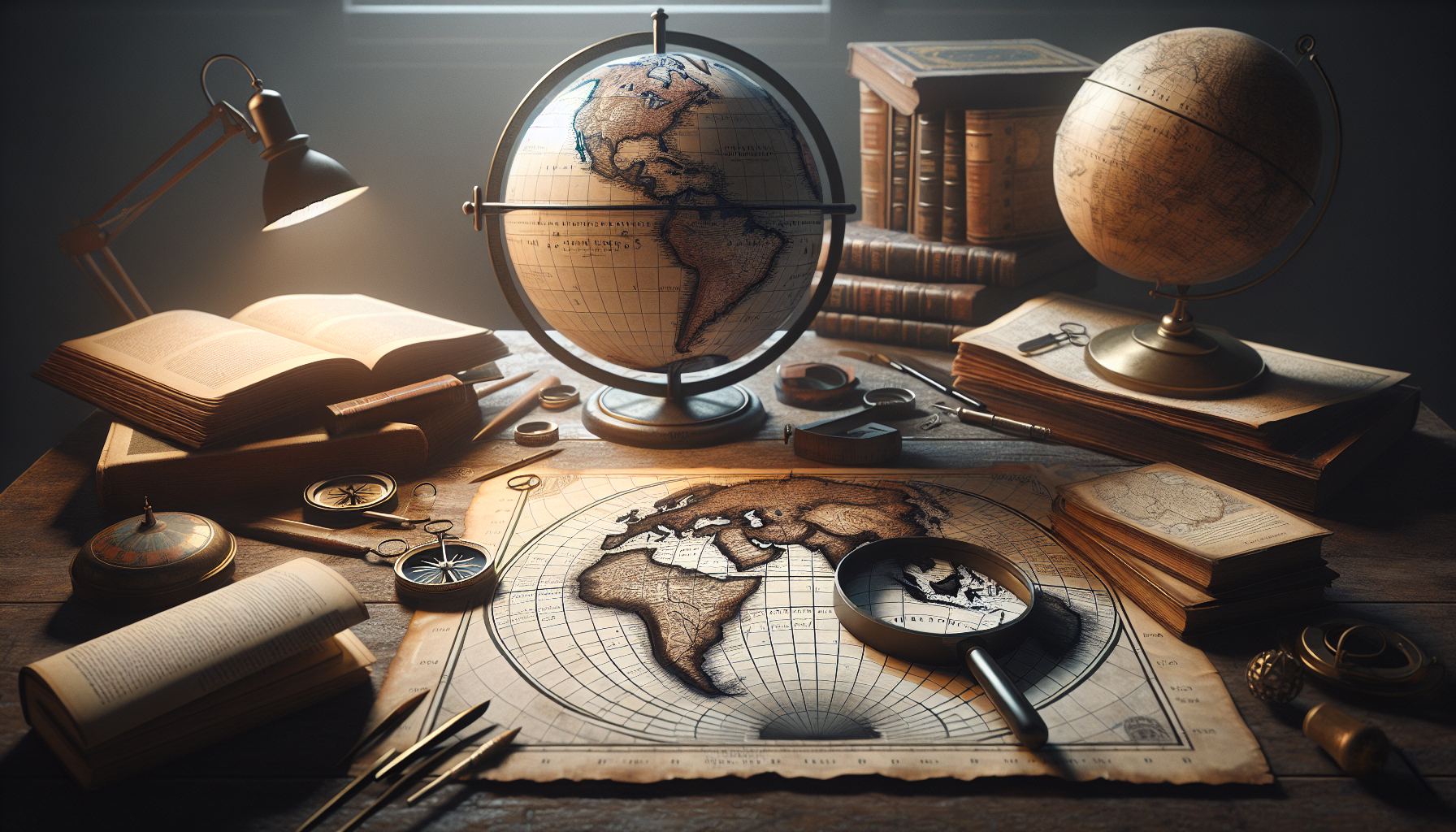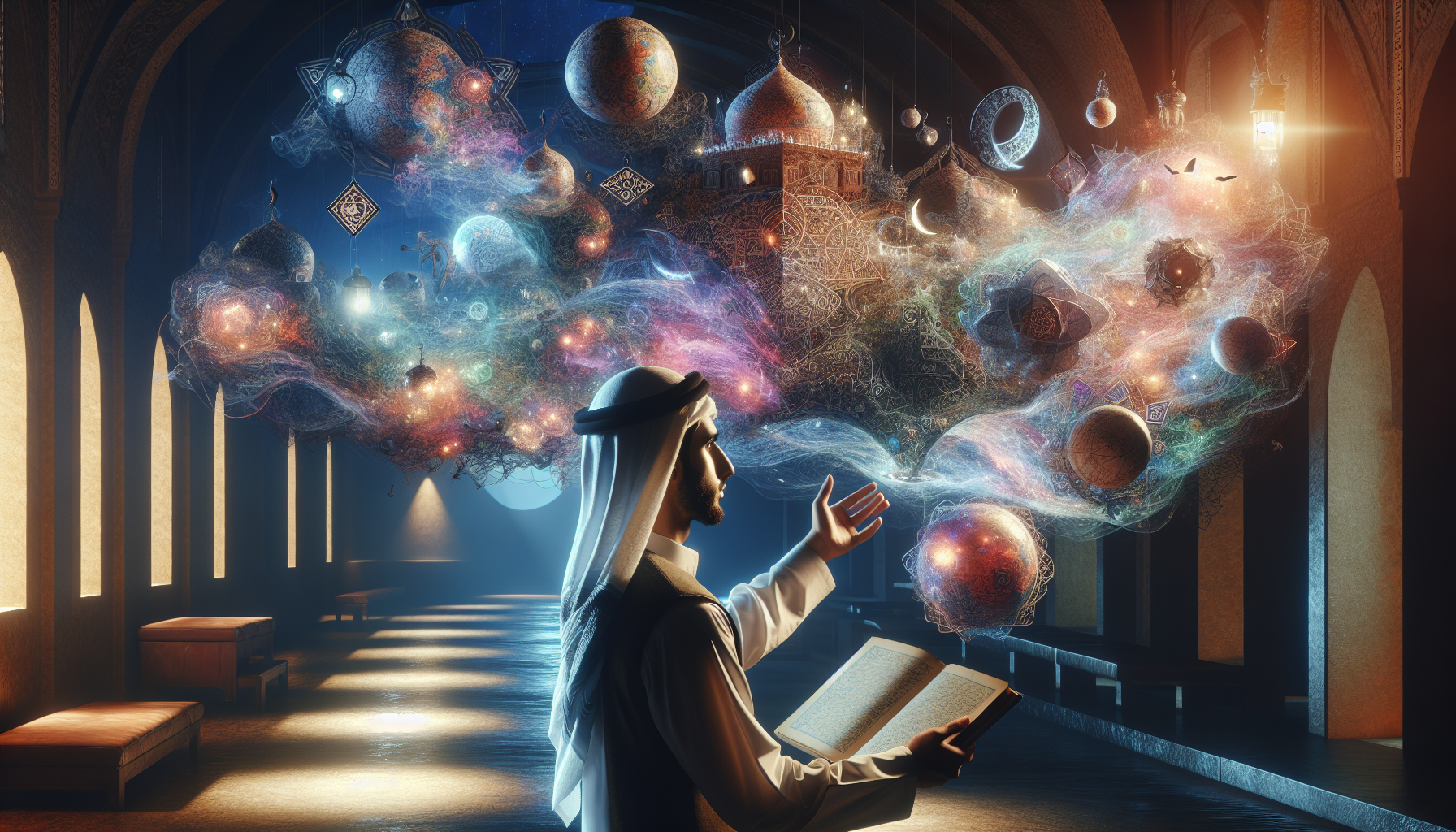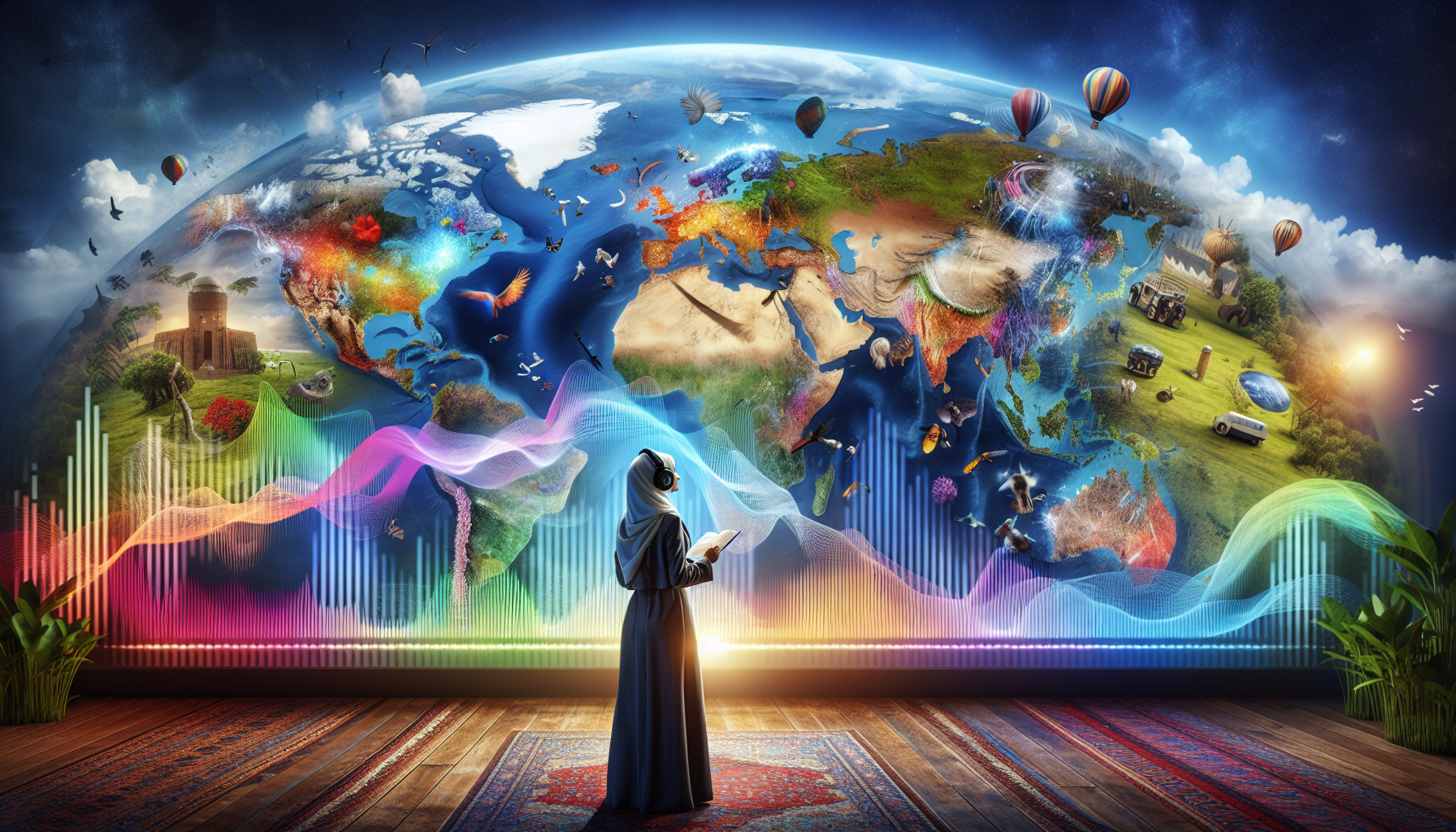광고
지도는 오랫동안 우리의 믿음직한 동반자였습니다. 낯선 지역으로 우리를 안내하고, 세상에 대한 우리의 이해를 형성하며, 심지어 지정학적 결정에 영향을 미치기도 합니다. 그것은 단순한 항해 도구가 아닙니다. 그것은 우리가 지구를 어떻게 인식하는지를 반영합니다. 그런데 우리가 의지해 온 지도가 생각만큼 신뢰할 만하지 않을 수도 있다고 말씀드리면 어떨까요? 가장 널리 사용되는 지도 투영법 중 하나인 메르카토르 투영법은 수 세기 동안 우리를 오도해 왔습니다. 이러한 탐험의 여정을 시작하면서 우리는 익숙한 표현 속에 숨겨진 기만의 층을 풀어내고 왜곡된 지리학의 심오한 의미를 탐구하게 될 것입니다.
광고
데이터가 손끝에 있고 기술이 지식의 격차를 메운 정보화 시대에, 오늘날 우리가 사용하는 지도는 그 어느 때보다 정확할 것이라고 생각할 수도 있습니다. 하지만 진실은 훨씬 더 복잡합니다. 플랑드르의 지도 제작자 헤라르두스 메르카토르가 1569년에 개발한 메르카토르 투영법은 공해를 항해하는 선원들에게 획기적인 도구였습니다. 일정한 항로나 항로선을 직선 구간으로 표현하는 독특한 능력 덕분에 해상 항해에 매우 귀중한 도구가 되었습니다. 하지만 이런 편의성에는 비용이 따릅니다. 메르카토르 투영법은 크기와 거리를 왜곡하여 세상을 왜곡된 시각으로 보여줍니다. 예를 들어 그린란드는 아프리카와 크기가 비슷해 보이지만 실제로는 아프리카가 그린란드보다 14배 이상 큽니다. 이런 왜곡은 단순히 지도 제작상의 특이한 점이 아니다. 이는 인식을 형성하고 심지어 문화적 편견을 강화할 수도 있습니다.
광고
메르카토르 투영법의 복잡한 내용을 더 깊이 파고들면 지도가 단순히 세상을 수동적으로 표현하는 것이 아니라 우리가 세상을 이해하는 데 적극적으로 참여한다는 사실이 분명해집니다. 창조 과정에서 내린 선택(투영 방식부터 강조되거나 생략된 세부 사항까지)은 우리의 세계관에 큰 영향을 미칠 수 있습니다. 이번 탐구에서 우리는 이러한 선택이 교육 과정부터 정치적 권력 역학에 이르기까지 모든 것에 어떤 영향을 미치는지 살펴보겠습니다. 메르카토르 투영법은 본질적으로 악의적인 것은 아니지만, 오해를 불러일으키거나 심지어 해로울 수 있는 이야기를 조장하고 잘못된 개념을 영속시키는 방식으로 사용되었습니다.
이 여정은 메르카토르 투영법의 결함을 이해하는 데서 끝나지 않습니다. 이는 우리 세계를 보다 정확하게 묘사하는 대안을 탐구하는 것으로 확장됩니다. 우리는 육지의 상대적 크기를 보존하는 것을 목표로 하는 갈-피터스 투영법이나 크기와 형태의 정확도 사이의 균형을 추구하는 로빈슨 투영법 등 다른 지도 투영법을 조사할 것입니다. 이러한 각 대안은 고유한 강점과 약점을 가지고 있으며, 3차원 세계를 2차원 평면에 표현하는 데 따르는 과제를 강조합니다. 이 탐구는 지도 제작 기술의 다양성을 밝혀낼 뿐만 아니라, 세계를 해석하는 데 사용하는 도구에 대한 의문을 제기하는 것의 중요성을 강조할 것입니다.
결국 이 탐구의 목적은 메르카토르 투영법을 비난하는 것이 아니라, 우리가 매일 사용하는 지도를 비판적으로 검토하도록 장려하는 것입니다. 다양한 지도 투영의 내재적 편견과 한계를 이해함으로써, 우리는 세상을 보다 섬세하고 정보에 입각한 관점으로 바라볼 수 있습니다. 지도는 지리, 문화, 정치에 대한 우리의 이해를 형성하는 강력한 도구입니다. 기만의 베일을 걷어내고 메르카토르 투영법의 진실을 찾아냄으로써 우리는 지구에 대한 보다 정확하고 포괄적인 관점을 향한 여정을 시작할 수 있습니다. 우리와 함께 이 매혹적인 풍경을 탐험하고, 우리 세계를 나타낸 지도 속에 숨겨진 진실과 신화를 밝혀내보세요.
메르카토르 투영의 역사적 맥락
수세기 동안 지도는 항해, 탐험, 교육에 필수적인 도구였습니다. 이 중 메르카토르 투영법은 플랑드르의 지도 제작자인 헤라르두스 메르카토르가 1569년에 창안한 이래로 중요한 위치를 차지해 왔습니다. 이 투영법은 당시로서는 혁신적인 것이었으며, 주로 해상 항해를 돕기 위해 고안되었습니다. 항로선이라고도 불리는 일정한 항로를 직선 구간으로 표현함으로써 선원들은 방위를 계속 조정하지 않고도 넓은 바다 위에서 직선 항로를 표시할 수 있었습니다. 이 기능은 대항해 시대에 매우 귀중한 것이었으며, 탐험가들이 더욱 정밀하게 지구를 탐험할 수 있게 해주었습니다.
메르카토르 투영법은 항해상의 이점에도 불구하고 육지의 크기를 왜곡하는데, 특히 적도에서 멀어질수록 왜곡 정도가 커집니다. 이러한 왜곡은 직선의 항정선을 유지하기 위해 투영 영역이 적도에서 더 멀어질수록 확대되기 때문에 발생합니다. 결과적으로 그린란드와 남극 같은 지역은 아프리카와 남미 같은 적도 지역에 비해 비례적으로 크게 보입니다. 이를 더 잘 이해하려면 실제 지역의 크기를 메르카토르 지도에 나타난 크기와 비교해 보세요. 실제로 아프리카는 그린란드보다 약 14배 더 큽니다. 그러나 메르카토르 지도에서는 두 나라가 거의 비슷한 크기로 나타납니다.
메르카토르 투영의 역사적 맥락과 발전 과정을 더 자세히 알아보려면 다음의 통찰력 있는 영상을 시청하세요. Vox의 "모든 세계 지도가 틀린 이유".
인식의 왜곡
메르카토르 투영법의 의미는 단순한 지도 제작상의 부정확성을 넘어선다. 그것들은 우리가 세상을 인식하는 데 영향을 미칩니다. 아프리카와 남미와 같은 대륙에 비해 유럽과 북미의 크기가 과장되어 이 지역의 지정학적, 경제적 중요성에 대한 인식이 왜곡되었습니다. 이러한 왜곡은 사회문화적 의미를 지니고 있으며, 유럽 중심적 관점을 강화하고 세계 역학에 대한 편향된 이해를 조장합니다. 메르카토르 지도는 특정 지역을 다른 지역보다 우선시함으로써, 세계 여러 지역의 크기, 중요성, 관련성에 대한 고정관념과 오해를 의도치 않게 영속시킬 수 있습니다.
더욱이 이러한 왜곡은 교육적으로도 부정적인 영향을 끼친다. 교실에서 메르카토르 투영법을 사용하면 학생들이 잘못된 정보를 접하게 되어 특정 지역이 다른 지역보다 더 두드러진다는 생각을 갖게 되어 지리에 대한 이해가 왜곡될 수 있습니다. 이번 호에서는 교육에 있어서 비판적 사고의 중요성을 강조하고, 교육자들에게 다양한 지도학적 관점을 제공하여 세상을 포괄적으로 이해할 것을 촉구합니다. 학생들이 제시된 정보에 대해 의문을 제기하고 비판적으로 분석하도록 격려하는 것은 보다 정확한 세계적 관점을 키우는 데 중요합니다.
다음 표를 살펴보면 국가의 실제 크기를 메르카토르 지도에 나타난 크기와 비교하고 있습니다.
| 국가/지역 | 실제 크기(제곱킬로미터) | 메르카토르 표현 |
|---|---|---|
| 아프리카 | 3020만 | 크게 감소 |
| 그린란드 | 216만 | 매우 과장됨 |
| 남아메리카 | 1784만 | 줄인 |
| 유럽 | 1018만 | 과장된 |
대체 지도 투영
메르카토르 투영법에 내재된 왜곡을 고려하여 세계를 더 정확하게 표현하기 위해 대체 지도 투영법이 개발되었습니다. 각 투영법은 면적, 모양, 거리, 방향 등 지도의 다양한 속성을 균형 있게 조정하는 데 고유한 접근 방식을 제공합니다. 가장 주목할 만한 대안으로는 피터스 투영, 로빈슨 투영, 윙켈 트리펠 투영 등이 있습니다.
피터스 투영법은 갈-피터스 투영법이라고도 하며, 정확한 면적 비율을 유지하여 크기 왜곡을 해결합니다. 이 투영법은 육지의 실제 크기를 강조하여 세상을 보다 공평하게 보여줍니다. 그러나 이 방법을 사용하면 국가의 형태 정확도가 떨어지고, 특히 적도 부근에서는 국가가 길쭉하게 보입니다. 이러한 사실에도 불구하고, 피터스의 투영법은 세상을 보다 균형 잡힌 시각으로 바라보고자 하는 기관과 교육자들에게 선호됩니다.
로빈슨 투영법은 면적, 모양, 거리, 방향의 왜곡을 최소화하도록 설계된 절충적 투영법입니다. 1963년 아서 H. 로빈슨이 개발한 이 도법은 세계를 시각적으로 보기 좋게 표현해 교과서와 교실에서 사용하는 세계 지도에 널리 사용됩니다. 메르카토르 투영법에 비해 육지 크기를 더 정확하게 묘사하는 동시에 전반적인 미적 매력을 유지합니다.
내셔널 지오그래픽에서 1998년부터 사용해 온 윙켈 트리펠 투영법은 면적, 방향, 거리의 왜곡을 줄이는 것을 목표로 합니다. 이 지도는 육지와 바다를 모두 정확하게 묘사하여 균형 잡힌 접근 방식으로 유명합니다. 경선을 약간 휘게 함으로써 윙켈 트리펠 투영법은 세계를 더욱 사실적으로 표현하여 오늘날 사용할 수 있는 가장 정확한 투영법 중 하나가 되었습니다.
이러한 대체 예측을 더 자세히 알아보려면 아래 표를 참조하세요.
| 투사 | 주요 특징 | 장점 | 단점 |
|---|---|---|---|
| 피터스 | 동일 면적 | 정확한 육지 크기 | 모양 왜곡 |
| 로빈슨 | 타협 | 시각적으로 매력적이다 | 사소한 왜곡 |
| 윙켈 트리펠 | 균형 잡힌 | 정확한 표현 | 최소한의 왜곡 |
지도학의 의미와 미래
21세기에 접어들면서 지도학의 역할은 계속해서 진화하고 있습니다. 디지털 기술과 위성 이미지는 지도가 만들어지고 사용되는 방식을 혁신하여 전례 없는 정확성과 세부 정보를 제공합니다. 인쇄된 지도의 기존 역할은 점차 사용자가 특정 지역을 확대해서 보고, 지형적 특징을 탐색하고, 심지어 실시간으로 길을 찾을 수 있는 대화형 디지털 지도로 대체되고 있습니다. 이러한 기술적 변화는 메르카토르 도법과 같은 기존 도법의 한계를 극복하고 세상을 더 정확하고 유익하게 표현할 수 있는 기회를 제공합니다.
교육 분야에서는 이러한 발전으로 지리학을 가르치는 데 더욱 포괄적인 접근 방식이 가능해졌습니다. 대화형 지도와 가상 지구본은 학생들에게 다양한 관점을 탐구하고 여러 관점에서 세상을 이해할 수 있는 기회를 제공합니다. 이러한 상호작용적 경험은 비판적 사고력을 키우고 세계 지리의 복잡성에 대한 더 깊은 이해를 돕습니다. 이제 교육자들은 학생들에게 다양한 예측을 소개하고, 각 예측의 강점과 약점을 평가하고 그 의미를 이해하도록 장려할 수 있습니다.
더욱이, 지도 제작 도구의 대중화로 인해 개인과 조직이 특정 요구 사항에 맞는 맞춤형 지도를 만들 수 있게 되었습니다. 오픈소스 플랫폼과 지리정보시스템(GIS) 덕분에 사람들은 다양한 응용 분야에서 정확하고 시각적으로 매력적인 지도를 더 쉽게 제작할 수 있게 되었습니다. 도시 계획, 환경 연구, 문화 연구 등 어떤 분야에서든 이러한 도구는 정보에 입각한 의사 결정과 향상된 커뮤니케이션을 위한 플랫폼을 제공합니다.
지도가 세상에 대한 우리의 인식을 어떻게 형성하는지 흥미롭게 살펴보려면 이 영상을 시청하세요. Geography Now의 "지도가 중요한 이유".
- 다양한 지도 투영법을 살펴보고 세계 지리에 대한 포괄적인 이해를 얻으세요.
- 지도 왜곡이 지정학적, 문화적 인식에 미치는 영향을 생각해 보세요.
- 디지털 지도 제작 도구를 사용하여 다양한 응용 분야에 맞는 맞춤형 지도를 만들고 분석합니다.

결론
결론: 속임수를 폭로하다: 메르카토르 투영법의 진실과 지도가 우리를 어떻게 오도할 수 있는지
메르카토르 투영법과 그 의미에 대한 탐구에서 우리는 지리, 정치, 인식이 교차하는 흥미로운 지점을 탐구했습니다. 우리의 여행은 1569년 헤라르두스 메르카토르가 개발한 메르카토르 투영법의 기원을 이해하는 것으로 시작되었습니다. 원래는 항해 목적으로 고안된 이 지도 투영법은 이후 우리 삶의 다양한 측면에 침투하여 우리가 세상을 보는 방식과 각 지역의 상대적 중요성에 영향을 미쳤습니다.
논의된 주요 사항 중 하나는 메르카토르 투영법에 내재된 왜곡에 관한 것이었습니다. 원통형 지도 투영법으로, 적도에서 멀리 떨어진 지역을 크게 확대하여 북반구 국가들이 실제보다 훨씬 크게 보이게 합니다. 예를 들어, 메르카토르 지도에서 그린란드는 종종 아프리카와 크기가 비슷해 보이지만, 실제로는 아프리카가 그린란드보다 약 14배 더 큽니다. 이러한 왜곡은 세계 지리와 권력 역학에 대한 우리의 이해에 심오한 영향을 미칩니다.
그런 다음 우리는 그러한 투영을 사용하는 것의 역사적, 정치적 결과를 탐구했습니다. 메르카토르 지도의 왜곡으로 인해 의도치 않게 유럽 중심적 관점이 영속되었고, 서양 국가가 강조되면서 적도에 가까운 국가의 시각적 중요성이 감소했습니다. 이러한 시각적 편견은 고정관념과 지정학적 권력 구조를 강화하여 대중의 인식과 국제 관계를 미묘하게 형성합니다. 더욱 정확하고 공평한 세계관을 키우려면 이러한 편견을 인식하는 것이 중요합니다.
또한, 우리는 세계를 더욱 사실적으로 묘사하기 위한 대체 지도 투영법을 조사했습니다. 갈-피터스, 로빈슨, 윙켈 트리펠과 같은 투영법은 면적, 모양, 거리를 표현하는 데 있어 다양한 정도의 정확도를 제공합니다. 각각의 예측에는 장단점이 있지만, 이를 종합적으로 고려하면 교육, 항해, 지정학적 분석 등 어떤 목적이든 적합한 지도를 선택하는 것이 중요하다는 점이 강조됩니다.
토론에서는 지도 활용 능력의 광범위한 의미와 교육에서 지도 활용 능력이 수행하는 중요한 역할에 대해서도 다루었습니다. 지도 활용 능력을 증진함으로써 개인이 자신이 접하는 표현에 대해 의문을 품고 이해할 수 있는 힘을 부여하고, 비판적 사고와 세계적 인식을 함양할 수 있습니다. 특히 시각적 정보가 풍부하고 종종 액면 그대로 받아들여지는 시대에 이는 매우 중요합니다.
결론적으로, 메르카토르 투영법에 대한 탐구는 지도 제작에 대한 기술적 논의 그 이상의 많은 것을 보여줍니다. 이는 우리가 역사적 편견, 문화적 인식, 표현의 힘을 살펴볼 수 있는 렌즈입니다. 다양한 지도 투영의 한계와 의미를 인식하는 것은 우리가 세상에 더욱 신중하고 공평하게 접근할 수 있게 해줍니다. 🌍
이 탐구를 마무리하면서, 일상생활에서 마주치는 지도를 되돌아보시기 바랍니다. 그들의 기원, 목적, 그리고 그들이 전달하는 메시지를 생각해 보세요. 이러한 지식을 적극적으로 활용하세요. 다른 사람과 통찰력을 공유하고, 제시된 지도에 의문을 제기하고, 다양한 관점을 찾아 세상에 대한 이해를 넓히세요. 그렇게 함으로써 우리는 더욱 정보에 기반하고 공평한 글로벌 커뮤니티를 만드는 데 함께 기여할 수 있습니다.
아래에 댓글을 남기거나, 소셜 미디어에서 생각을 공유하거나, 새로운 지도 투영법을 탐구하고 그 중요성을 다른 사람들에게 알려서 배운 내용을 적용해 보세요. 한 번에 한 장의 지도씩, 세상에 대한 우리의 이해와 표현을 바꿔봅시다. 추가 자료를 읽으려면 다음과 같은 리소스를 탐색하세요. 미국 지리학회 그리고 내셔널 지오그래픽의 지도 정책 여러분의 지식을 심화시키고 이 중요한 대화를 계속하세요. 📚
이 깨달음을 주는 여정에 동참해주셔서 감사합니다. 우리는 호기심과 비판적 태도를 유지하고 지도가 담고 있는 진실을 밝히기 위해 헌신하며, 세상을 보다 섬세하고 포괄적으로 보는 시각을 갖도록 노력해야 합니다.
토니 산토스 디지털 지도 제작자이자 시각적 사고자이며, 놀랍도록 기이한 것들을 큐레이터로 활동합니다. ~에 아이사프그는 야생의 세계로 뛰어든다 기괴한 지도, 상상의 지리, 그리고 대안적인 지도학적 현실우리가 주변 세계를 보는 방식, 느끼는 방식에 대한 새로운 관점을 제공합니다.
그의 작업은 다음과 같은 믿음에 뿌리를 두고 있습니다. 지도는 단순한 항해 도구가 아니다. 그것은 인식, 기억, 상상, 심지어 신화로 통하는 관문입니다. 왜곡된 역사 도표부터 초현실적인 지형, 음모 지도, AI가 생성한 세계 구축까지 토니는 논리에 도전하고 호기심을 불러일으키는 지도를 제작하고 수집합니다..
스토리텔링, 예술 및 상징적 탐구 분야의 배경을 가진 Toni는 Aysapp을 플랫폼으로 사용하여 공개합니다. 잊혀진 장소, 보이지 않는 경계, 그리고 새롭게 상상된 현실. 그의 창작물은 '세상이 거꾸로 된다면 어떨까?'와 같은 질문을 던진다. 지도가 지리적 진실이 아닌 감정적 진실을 말해준다면 어떨까?
창조자로서 아이사프그는 임무를 수행 중입니다 호기심을 불러일으키다창의적인 사고를 장려하고 상상력, 문화, 공간적 스토리텔링의 교차점을 한 번에 한 개의 이상한 지도를 통해 탐구합니다.
🌀 그의 지도학적 우주는 다음을 탐구합니다.
-
비현실적이지만 의미 있는 풍경
-
감정, 기억, 그리고 지리로서의 신화
-
숨겨진 진실을 드러내기 위해 왜곡된 지도
당신이 판타지 세계를 좋아하는 사람이든, 지도 수집가든, 호기심 많은 여행가든, 아니면 특이한 것을 좋아하는 사람이든, 토니는 당신을 지도학적 상상력의 가장 특별한 구석으로 의도적으로 길을 잃도록 초대합니다.




